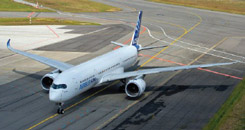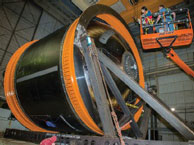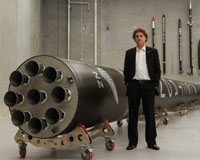Also, download this story from the electronic issue here
Fibre-reinforced composites will play a major role as one of the key technologies for the 21st century, due to the continuing trend toward energy-saving lightweight construction and the superlative performance that these materials can provide. The aerospace sector is one of the industries enjoying the benefits of composites.
Hexcel’s carbon fibre used for A350
Aerospace group Airbus has received Type Certification for the A350 XWB, which means the aircraft is now ready for flight operations during the fourth quarter of 2014. The A350 XWB is the first Airbus aircraft with a structure that is over 50% advanced composite materials, making a huge contribution to the weight-saving, performance, and fuel efficiency of the aircraft.
Contributing to the aircraft is composites firm Hexcel that supplied its HexPly M21E/IMA carbon fibre/epoxy prepreg to manufacture all composite primary structures of the aircraft, including the fuselage panels, keel beam, wing and the empennage.
The A350 XWB lower wing cover is also the biggest single civil aviation part ever made from carbon fibre, measuring 32 m long. In addition to the primary structures, Hexcel is supplying a number of HexPly prepregs for other structures on the A350 XWB, including the epoxy systems HexPly M21 and HexPly 8552, and the BMI system HexPly M65. The HexPly 8552 woven and UD prepregs, HexPly M65 woven BMI prepreg and HexPly 914/ASC woven prepreg are used in the engines and nacelles along with Hexcel’s engineered core.

The belly fairing is made from Hexcel’s HexPly M26T and F593 woven carbon prepregs and HexWeb Engineered Core is also used extensively in several sandwich component packages.
Other Hexcel products on the A350 XWB include HexFlow RTM 6 infusion resin and HexForce engineered reinforcements for out of autoclave structures, Redux adhesives and lightning strike protection solutions. Hexcel’s total content on each A350 XWB is US$5 million.
Evonik’s foam structure proves to be economical
Meanwhile, German chemicals firm Evonik Industries’s Rohacell Hero polymethacrylimide (PMI) foam core material, used in a composite sandwich design, has been found to reduce manufacturing costs by 20% and part weight by 10%, compared to a typical honeycomb design.
In the past, there have been limitations in applications where safety is paramount and where parts are exposed to extreme temperature fluctuations and high levels of mechanical stress, such as rudders or landing gear doors. Until now, only honeycomb composites were able to meet these demands.
A study was undertaken by Germany-based Composite Technology Centre (CTC), a subsidiary of Airbus, on the nose landing gear doors of a Dornier 728, which were manufactured using Rohacell Hero foam core and the infusion process. The doors, fabricated by German firm Invent, were compared with a part manufactured using honeycomb core material and prepreg.
Other benefits in using Rohacell, compared to a honeycomb core, include the closed cell structure of the PMI material, which means it is not necessary to apply either a core filling paste potting material, as there are no open edges to seal, or an adhesive film to bond the core to the skins. This allows for cost savings and reduces the preparation time by four hours, according to CTC.
Furthermore, Evonik says its Hero material has an elongation at break that is three times higher (9-10%) than standard materials. As a result, even at temperatures of below minus 55°C, it is still mechanically resilient compared with honeycomb structures. If damage is caused, for example, by foreign objects being hurled up from the runway, sandwich structures made with Hero exhibit visible dents, which remain local and do not spread.
Rohacell is already being used in Asia’s aviation industry, including the regional jet ARJ21-700 and also the prototype of China’s first large commercial airliner C919 that is scheduled to enter commercial service in 2018.
Following the study and material testing by Airbus for two years, the aerospace group expects the first components made from the material to be produced in series in 2015.
Investments for growing sector
In view of the growth, Hexcel will expand its carbon fibre production capacity through the addition of new precursor and carbon fibre lines in Roussillon, France, through a US$250 million investment. In recent years Hexcel has increased its precursor and carbon fibre capacities through targeted expansions at its US facilities and is currently installing its resin mixing and filming technology – first developed in Europe – in the US. The new French plant will occupy a 37-acre site at the Osiris Chemicals Industry Platform in Roussillon, which is close to Hexcel’s weaving and prepreg manufacturing facilities near Lyon. Carbon fibre from the new plant will be supplied to Airbus for the A350 XWB and Safran for the CFM LEAP engine. Construction of the new plant will begin by mid-2015 and will be fully operational in early 2018.
Meanwhile, Evonik plans to build a new plant for Rohacell in Shanghai, China, scheduled to begin operation in the fourth quarter of 2015. Currently two plants, in Darmstadt, Germany, and Mobile, Alabama, US, supply customers in Asia. The new facility will be located in Evonik’s Multi-User Site China (MUSC) in Shanghai Chemical Industry Park (SCIP).
The foam cores are ideal for the growing advanced composites industry and are enjoying increasing worldwide demand in not only the aviation industry, but also in automotive, electronics, medical technology and sporting goods.
Lighter space flight
Composites have also conquered the interplanetary space. From the pre-Russian “Sputnik” days of launched research rockets made with Bakelite composite materials, and space vehicles using metal-matrix composites (such as in the 1999 robotic spacecraft, Mars Polar Lander), to advanced composites being used in current space crafts, the aviation industry has gone definitely more lightweight and faster in flight.
The National Aeronautics and Space Administration (NASA) has been continuously researching and developing composites that will enable lightweight and temperature/zero-pressure-resistant space craft for exploration.
Recently, NASA has completed a complex series of tests on one of the largest composite cryogenic fuel tanks ever manufactured. The tank, which measures 18 ft in diameter, was built by the Chicago-headquartered Boeing. For a long time, fuel tanks responsible for launching rockets into space have been made of metal.

The technology will provide an option for other industries that may want to replace heavy metal components with lightweight composites.
The tests were carried out at NASA’s Marshall Space Flight Centre in Alabama. Engineers added structural loads to the tank to replicate the physical stresses launch vehicles experience during flight.
In other tests, the tank successfully maintained fuels at extremely low temperatures and operated at various pressures. Engineers filled the tank with almost 30,000 gallons of liquid hydrogen chilled to -423°F, and repeatedly cycled the pressure between 20 psi to 53 psi – the pressure limit set for the tests.
The project is part of NASA's Space Technology Mission Directorate, which is innovating flying hardware for use in NASA's future missions. The authority says that composite cryogenic tanks promise a 30% weight reduction and a 25% cost savings over the best metal tanks used today. It will also embark on developing nextgeneration technologies including composite systems that will upgrade the capabilities of rockets as well as lower the cost of making them.

Another company, New Zealand-based Rocket Lab, has developed a space vehicle, which will first launch by 2015. Called Electron, it has an all-carbon-composite payload fairing. Weighing less than 30 kg, the payload fairing maximises the payload weight to orbit, while providing the requisite protection for the vehicle during assembly and flight.
The 10-tonne rocket, which is also smaller than the average 60-m length rockets, is said to be capable of carrying up to 120-kg weight satellites and sending them into space for less than US$6 million, a fraction of current costs.
Equipped with ten Rutherford engines, Electron will also reduce the time it takes to launch a satellite from years to weeks, according to Rocket Lab. It says that once the current functional deployment tests are complete, the fairing will undergo extensive environmental testing and integration with the payload supporting structures.
(PRA)























